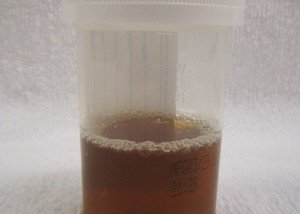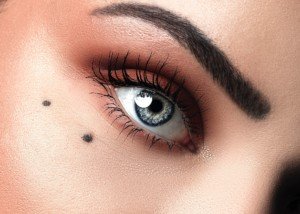![]()
Surgical mole removal is not painful at all. At least, it wasn’t painful for me, and I have had six moles removed surgically.
But I’ve had this procedure done six times now, to remove moles, and there is no pain.
You will feel the needle insert into your skin. It is less painful than a paper cut. In fact, sometimes paper cuts can hurt like $#$#!
Having a mole removed is also a lot less painful than undergoing facial extractions.
Any woman who’s had a facial knows how biting painful the extraction process is on the nose.
One of the moles I had removed was on my cheek, and I’m not even sure I ever felt the needle for the anesthetic.
Once the area is numbed, you absolutely cannot feel the doctor surgically remove the mole.
The first spot I had taken out was about 4 and a half millimeters in diameter, and that’s why I wanted it removed, since I had been reading that moles over 4 mm should be removed, since they are more likely than tiny ones to ever turn into melanoma.
It was on my lower abdomen. I was lying on my back during the procedure, and after feeling just a hint of a needle for a very brief moment, never felt anything after that.
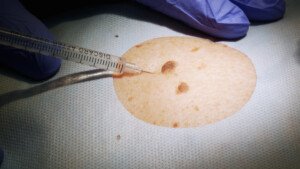
Shutterstock/Diedov Denys
The removal procedure was a diamond-shaped incision that included a margin of skin around the spot.
The recovery of this mole removal was also painless.
All you do is change the bandage every day and clean the area every day.
The stitches can be removed by the patient after 7-10 days, depending on location of the incision.
The second mole I had removed was on my cheek, and again, no pain, just the sensation of the needle penetrating the skin.
Just because you can feel this happening, doesn’t mean it will be painful, like a facial extraction, paper cut or someone deliberately jabbing a sewing needle into your cheek.
The removal procedure for this mole was a “punch” procedure.
The instrument, that’s shaped like a tiny cylinder, is placed over the mole.
The instrument’s diameter is bigger than the mole, to allow for a margin of skin around the spot to be removed.
The instrument is then “punched” through the skin, to also collect a margin of skin underneath the spot.
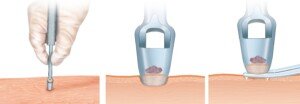
Punch biopsy. Shutterstock/ilusmedical
Again, recovery is pain free and involves keeping the area covered with a Band-Aid for a week, changing the Band-Aid daily (and putting Vaseline on the Band-Aid). I removed the stitches myself after seven days.
I had the cheek mole removed because the top layer was quickly flaking off, but it turned out to be benign.
Shave Procedure
The third and fourth moles I had removed were on my back and shoulder, and involved a “shave” procedure, which isn’t as invasive as the punch or diamond incision.
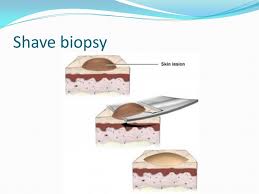
The shave is just that; the spot is shaved off the skin, but the shave includes a margin of skin around and beneath the mole.
I had these two removed electively because I wanted to “de-mole” myself, figuring that this would reduce my chances of ever getting melanoma.
The fifth spot removed actually wasn’t a mole; it was a seborrheic keratosis, on my back.
But I had thought it was a mole (the doctor said it looked more like a seborrheic keratosis, but because it was changing in appearance, I insisted she use the “punch” procedure to get it all out).
The punch procedure is just as painless as the shave. The stitches had to be removed 7-10 days later.
Stitch removal is painless, and the only reason I had to have a doctor do it was because it was on my back.
The sixth mole removed was actually a lentigo (sunspot), but the procedure is the same, and in this case, it was a shave.
Sometimes, lentigos are indistinguishable from moles, and even a dermatologist cannot tell the difference.
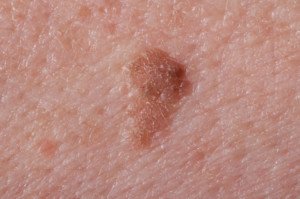
Lentigo. Shutterstock/Roblan
The only way to tell one tissue type from the other is under a microscope.
I had this lentigo removed because it went from brown to reddish-brown in only a few days.
A lentigo can turn into melanoma. Mine, however, turned out to be benign, despite changing colors.
Because the lentigo was on the front of my lower leg, I was able to observe the entire procedure.
The shave involves a tiny instrument with a curved razor. The doctor places it beside the mole/spot and simply glides it across the skin.
The curvature picks up the mole, along with a margin of skin beneath it.
Mole removal at home has one major disadvantage:
You can’t get the spot biopsied.
Whenever you have a mole or spot removed, it should always be biopsied, no matter how normal it looks.
This means if you want a spot removed for vanity reasons, it still should get biopsied!
I read about a young woman who had a large mole on her shoulder taken off, and the doctor tossed it into the rubbish.
A few years later the area of removal began itching.
The doctor had failed to remove every last bit of the mole; what remained had morphed into melanoma.
In fact, at the time of the removal, it’s possible that the melanoma was already in progress, though asymptomatic.
The woman ended up dying because the melanoma cells had spread.
Forget pain; if you want a mole removed, have a dermatologist do it, and request a biopsy.

